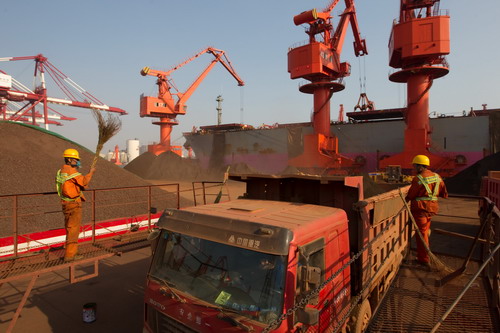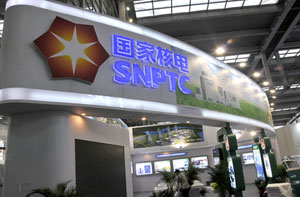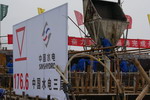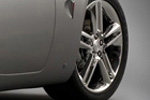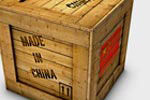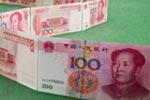Self-sufficiency in ore expected to pass 50%
Updated: 2011-09-29 09:11
By Zhang Qi (China Daily)
|
|||||||||||
|
Workers unload iron ore powder in Qingdao port, Shandong province. China is now importing iron ore from many non-traditional sources, such as Iran and Indonesia. [Photo/China Daily] |
Nation plans to enhance investment in mining projects around the world
QINGDAO, Shandong - China will achieve a self-sufficiency ratio of domestic ore over 50 percent, and moderately enhance Chinese-invested overseas ore resources, a move that signals the nation intends to prudently seek overseas mining resources.
Zhang Changfu, the vice-chairman of the China Iron and Steel Association (CISA), said at a conference on Sept 28 that the Chinese steel industry has set a target in the 12th Five-Year Plan (2011-2015) to achieve a self-sufficiency ratio of domestic ore at 50 percent and moderately enhance the ore proportion from Chinese-invested overseas resources.
CISA earlier said China currently owns less than 10 percent of the imported iron ore and urged the country to increase ore imports from Chinese-invested resources.
China has overseas mining rights capable of producing 150 million tons of ore annually, but most of the mines have yet to start production, according to data from CISA. About 60 million tons of imported iron ore came from mines that had Chinese investment in 2010.
The country has been enthusiastically seeking iron ore resources overseas so as to break the grip of the three major global miners -Vale SA, Rio Tinto and BHP Billiton - which controlled 62 percent of the world's seaborne iron ore market in 2010.
Han Qing, president of Shougang Co Ltd, a listed arm of Shougang Group, said at the same conference that Shougang is working with a US investment company to acquire an open-pit magnetite iron ore mine in Western Africa, estimated to hold 1 billion tons of deposits.
He said the company plans a $1 billion iron ore mine expansion in Peru. Han also said Shougang expects to be self-sufficient in iron ore supplies by 2015 by gaining domestic and overseas iron ore rights, from the current self-sufficiency of 50 percent.
Dai Zhihao, vice-president of Baosteel Group, also said Baosteel is actively seeking to develop iron ore mines in Africa.
Imports from suppliers other than Australia, Brazil, India and Africa account for 18.4 percent of total imports and are up more than 5 percent from last year, he said. "Those countries that have never exported iron ore to China are now listed among the exporting countries, such as Iran and Indonesia," he said.
He said global supply and demand conditions for iron ore may reverse sooner than expected, as a flurry of investment in mining due to rising ore prices resulted in huge production expansion. That will also end the global iron ore shortage, and the consequent oversupply will weigh on iron ore prices.
BHP is spending $7.4 billion on its operations in Western Australia's Pilbara region to boost output 64 percent to 220 million tons by 2014 while Rio is expected to add 50 percent to its annual capacity by 2015.
Neville Power, CEO of Fortescue Metals Group Ltd, said he expects iron ore prices to remain high until 2012 with new supplies entering the market in 2013.
He said Fortescue aims to expand annual production capacity to 155 million tons by 2013 from 55 million tons now.
Related Stories
Imported iron ore supplies decline in China 2011-09-28 13:36
CISA to publish weekly iron ore index to reflect domestic market 2011-09-21 13:28
Import prices of iron ore climb last week 2011-09-06 13:26
China collecting new sources overseas to provide iron ore 2011-09-02 11:33
- China expands lending to fund-hungry small firms
- '9% GDP growth' for 2011
- Self-sufficiency in ore to pass 50%
- Citic Securities raises $1.7b in HK
- Foreign pilots call for better safety systems
- Crunch comes for those with underground loans
- Mayor sorry for demolition death
- Minimum wheat purchase prices raised for '12
